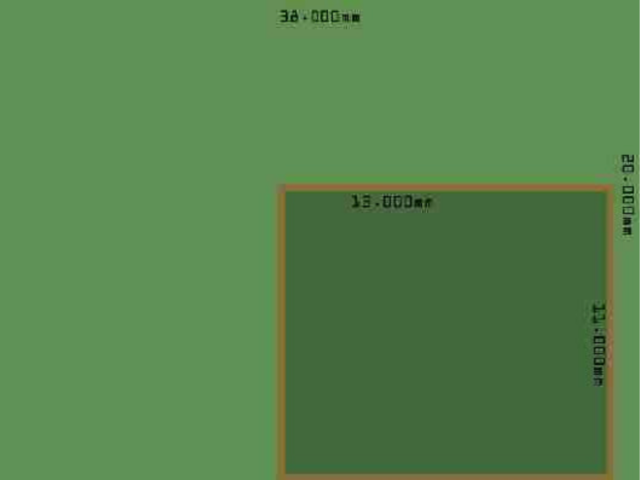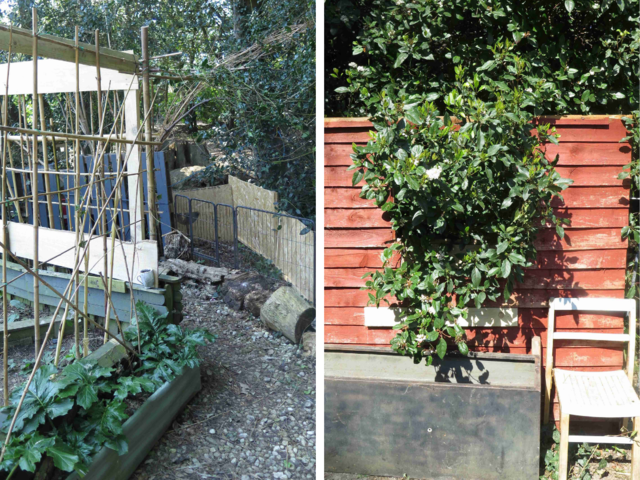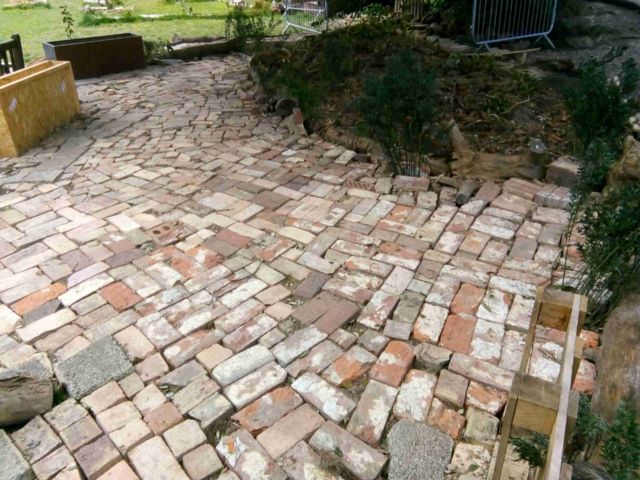Luca M Damiani is an artist and lecturer in Graphic and Media Design at the University of the Arts London. Focusing on artistic research in neuroscience, neurodiversity and mental health, Luca's ongoing practice is based on the observations of his own sensory disability and neurological disorders.
In this blog post, Luca shows us how he designed and created his upcycled therapy garden in the Markwick Gardens (St Leonards-on-Sea, Hastings).

Figure 1 – Artist Luca M Damiani in Markwick Gardens, St Leonards-on-Sea (Hastings). Image courtesy: Luca M Damiani.
Gardening the soul
While the Covid-19 pandemic has been tough for everyone, gardens have saved many of our souls by helping us connect with our inner selves and giving us the space to engage with family members and others in the community. Experienced gardeners have kept developing their skills, and many others have started to discover gardening for the first time, learning new skills and experiencing a beautiful new lifestyle.
Therapies on hold
I suffer from a sensory disability and neurological condition as a consequence of an accident in January 2018. My life has been massively affected by neurological trauma. I now have chronic pain, vertigo attacks, persistent dizziness connected to posture and perception of movement and space, and sensitivity to sound and light.
Due to Covid-19 lockdowns, many of my specialist treatments had to be paused because they could not be carried out online. These therapies treat my persistent dizziness, chronic pain, sound sensitivity, and vertigo attacks and focus on my mental health and help prevent sensory overload. However, I am happy to say that gardening and garden design has played a massive therapeutic role in my life, not only as of the therapy itself but also as part of my artistic and research practice. Not only has gardening helped me with my condition, but it has also allowed me to draw and reflect on my new life.
The Academy of Garden Design
I have always loved plants and nature but never had the chance to really explore gardening and garden design until 2020. Around that time, I used to visit my local park, the beautiful Markwick Gardens in St. Leonards-on-Sea, to help process everything that had happened to me since my accident in 2018. I then decided to join the Academy of Garden Design to learn more about gardening.
During the course, I was able to apply my therapies to my garden design practice. In fact, as part of one project, I designed a whole new area – a therapy garden – for the Markwick Gardens.
Creating the therapy garden
When creating the therapy garden, my inspiration came from many places: mental health, therapy, design and gardening. Because I wanted the garden to reflect my neurological disorders and sensory disability, these influenced each aspect of the design.
There was an area of the Markwick Gardens that was almost abandoned, and I wanted to bring it back to life. In doing so, I visualized my own rebirth, almost like reconstructing parts of me that were not there anymore. I focused on concepts like ‘feeling stuck in my condition’, ‘feeling broken’, ‘possibility’ and ‘new directions’.
There were many parts involved in developing the garden, for example, the design, troubleshooting, presenting ideas, and health and safety guidelines. I felt that my relationship with the garden constantly changed, and new ideas for planting, structure and maintenance emerged as I spent more time in the space.
Initial development and sketches

Figure 2 – Initial sketch of the space with measurements. Image courtesy: Luca M Damiani.
I started working on the therapy garden in March 2020. It was an empty, unused part of the wider gardens, with no plants and some broken fencing surrounding it. The area had inferior drainage on the right side and arid soil on the left side (due to two oak trees taking all the water from the ground). It was an area calling out to be redesigned.
Speaking to different members of the Markwick Gardens, it became clear that people wanted to breathe new life into this area. Feedback from the members also helped to shape the primary design concept, which involved upcycling. Upcycling is the reusing of materials. It is good for the environment, gives new life to the materials involved, and evokes feelings of rebirth and new possibilities for the designer and end-user.
As a member of the Marwick Gardens myself and as a gardening volunteer there since late 2018, I took the challenge of taking all the fencing down. This was hard work because of my condition, and I had to take things slowly. The process was very therapeutic and allowed me to incorporate some exercises for postural and perceptual balance, as well as other exercises for pain management. As my rehabilitation exercises were such a large part of my daily routine while working in the garden, I felt the need to put them into the design. So, I started to sketch the design of the garden with each part conceptually connected to my journey and the processing of neurological trauma.

Figure 3 – Initial concept sketch for the proposed design in Markwick Gardens. Image courtesy: Luca M Damiani.
I planned to create:
-
A wildlife path and a woodland feel for the whole area. This would connect the existing paths in the Markwick Gardens to the therapy garden and create a small woodland section of the gardens.
-
A herb garden to bring a new look and fragrance to the area
-
A birdbath for new life, sights and sounds
-
A logging area to bring new life to the very dry areas of the garden
-
A dog agility area for our wonderful dogs and to create a space that reflects mobility
-
A tunnel path with climbing plants to create an adventurous feel
-
Different ‘natural rooms’ and benches create an environment where people could also spend time together and yet also have privacy to think and meditate

Figure 4 – Concept plan. Image courtesy: Luca M Damiani.
Planting
Once the concept was developed, I created a working plan which initially focused on the right side of the space.

Figure 5 – Concept/working plan. Image courtesy: Luca M Damiani.
At this point of the design work, I started to connect with the surrounding space more and more in sound and smell. I also observed how the area could be further balanced with a colour palette of white, green and brown, in various layers and tones.

Figure 6 – Color balance and palette for the primary wider design. Image courtesy: Luca M Damiani.
These colours were applied when thinking about the planting, the flowering process, building the structures, and all the materials involved. The combination of these three colours connected the area to the wider gardens. It also gave a natural look to space.
The members of the Markwick Gardens donated plants and materials, and it was fantastic to include these in the design. We now have sixteen hydrangeas in a space called the Hydrangeas Hug. They will flower beautifully and are easy to shape. In the future, this space will be a labyrinth of hedged pathways and atriums.
I added succulents in different places, as well as more tropical and Mediterranean trees such as fig trees, orange trees, banana trees and palm trees in the area that needed some help with drainage.
It was also important for me to have some of my favourite childhood plants in the garden. This was therapeutic because it allowed me to reconnect with myself. As I am from Sardinia in Italy, I added three jasmines, three bougainvillaeas (pink-purple, white, and orange-yellow) and some other creepers. In the future, I will also add giant sunflowers.
The height of the garden was considered. For example, the heights of the plants, trees and structures (such as the bamboo tunnel path) were designed to reach a maximum height of 4 metres. Combining this with a maximum height of two metres for the hydrangeas, smaller plants, and herbs will create a lovely well-balanced space.
Celebrating the garden's first anniversary
In the following photographs, you can see how the garden developed in its first year.

Figure 7 – Construction of Bamboo tunnel. Image courtesy: Luca M Damiani.

Figure 8 – Skeleton of the design. Image courtesy: Luca M Damiani.

Figure 9 – Creating the Herb garden. Image courtesy: Luca M Damiani.

Figure 10, 11 – First fixed bench. All benches in the garden had been in a state of disrepair and were all fixed with extra pieces of wood. / Overview of the herb garden structure and an overview of the ‘natural rooms’ perimeter. The perimeter area has 16 hydrangeas planted, rosemary and other plants to create proper pathways and private spaces. Image courtesy: Luca M Damiani.

Figure 12 – Bamboo house structure. This will be covered by one jasmine and one pink bougainvillaea, creating a lovely en enclosed and safe space. Image courtesy: Luca M Damiani.

Figure 13 – This area is always in shade due to the big oak tree. The shade from the tree was a consideration in the design of a small hill with moss. Image courtesy: Luca M Damiani.

Figure 14, 15 – Details of planting (a rose in the garden). / Ornaments (a mirror and a structure to cover a plastic water-butt). Image courtesy: Luca M Damiani.

Figure 16 – The decking I made for the herb garden. Image courtesy: Luca M Damiani.

Figure 17 – Garden view from the herb garden. Image courtesy: Luca M Damiani.

Figure 18 – The herb garden structure with ivy growing on the bamboo. Image courtesy: Luca M Damiani.


Figure 19, 20, 21 – A donated broken birdbath pole, bird-house and broken bench. All fixed and up-cycled for re-use in the gardens. The donations also become an essential element of inclusion and attachment to the gardens. Image courtesy: Luca M Damiani.

Figure 22 – A donated broken bench and a broken shed, re-designed as a sheltered bench. Image courtesy: Luca M Damiani.

Figure 23 – I call this one “Not Only a Bird Bath” - I created this with donated tiles, a water pipe and a bin lid. It was supposed to become a birdbath, but the bin lid (top) cracked, so I redesigned it as a raised bed for succulents. Image courtesy: Luca M Damiani.


Figure 24, 25, 26, 27 – More pathways and additional donations from members as up-cycling addition to the design. Image courtesy: Luca M Damiani.

Figure 28, 29 – On the side of the herb-garden structure, there will be an enclosed room for meditation, which should receive all the perfumed smells of the herbs. Jasmine will also creep on the bamboo, releasing another intense and lovely fragrance. Paving stones and stones have all been donated by different members of the gardens. Image courtesy: Luca M Damiani.

Figure 30, 31 – More planting (one willow tree, two camellias, one apple tree and more – all donated) are added in the middle of the field to create an oasis that will act both as a good central point as well as helping with the practicality of the drainage of the soil. Picnic benches have been added for groups of friends and families. And a dog agility set-up. Image courtesy: Luca M Damiani.


Figure 32, 33 – Ongoing development of patio-paving created with donated broken bricks. Soil fills in the gaps, and flat succulents will be planted to grow between the bricks. The patio paving will be constructed in different parts of the garden, adding another element of consistency to the overall design plan. Image courtesy: Luca M Damiani.

Figure 34 – In progress construction of a “sofa-bench”. An old broken sofa donated by a member of the Gardens. The aesthetic will recall other elements of the gardens, such as the herb garden structure, the sheltered bench, and other fixed benches and raised beds. A patio-paving will also surround this sofa bench. Image courtesy: Luca M Damiani.
Next steps
Currently, I am continuing to work on planting while also adding ornaments and sculptures. My next aim is to create a space where the eye wanders, and each design element takes you on a journey through the garden.

Figure 35 – Take your time, rest and look up. Image courtesy: Luca M Damiani.
When I started the design, I had lots of feelings of grief, loss and pain. The garden was a blank canvas, and by shaping it, I began to heal myself. With some ‘guerilla gardening’, structured garden design and more than a year of hard work from myself and members from the Marwick Garden, I can say that the initial foundation is finally complete. Now is the time to take a rest and let nature do its magic. I want to sit back and look up and breathe.
With thanks to everyone at Markwick Gardens and the Academy of Garden Design.
Inspired by Luca's experience? Here's how we can help you pursue your passion for gardening.
About the author: Luca M Damiani is an artist and lecturer in Graphic and Media Design at the University of the Arts London. Luca practices internationally in the fields of art and design and their connection with neuroscience. A published artist/author of several books and papers, Luca's work is actively exhibited and showcased. He has collaborated with many institutions, including the Computer Arts Society, Mozilla Foundation, NESTA, Amnesty International, BBC, Disney, TATE, V&A and Thames & Hudson. www.lucadamiani-art.com.
This is a guest post by Luca M Damiani. The opinions expressed by the guest writer are his alone and do not necessarily reflect the opinions of the Academy. We bear no responsibility for the accuracy of any of the information supplied by the guest writer.


